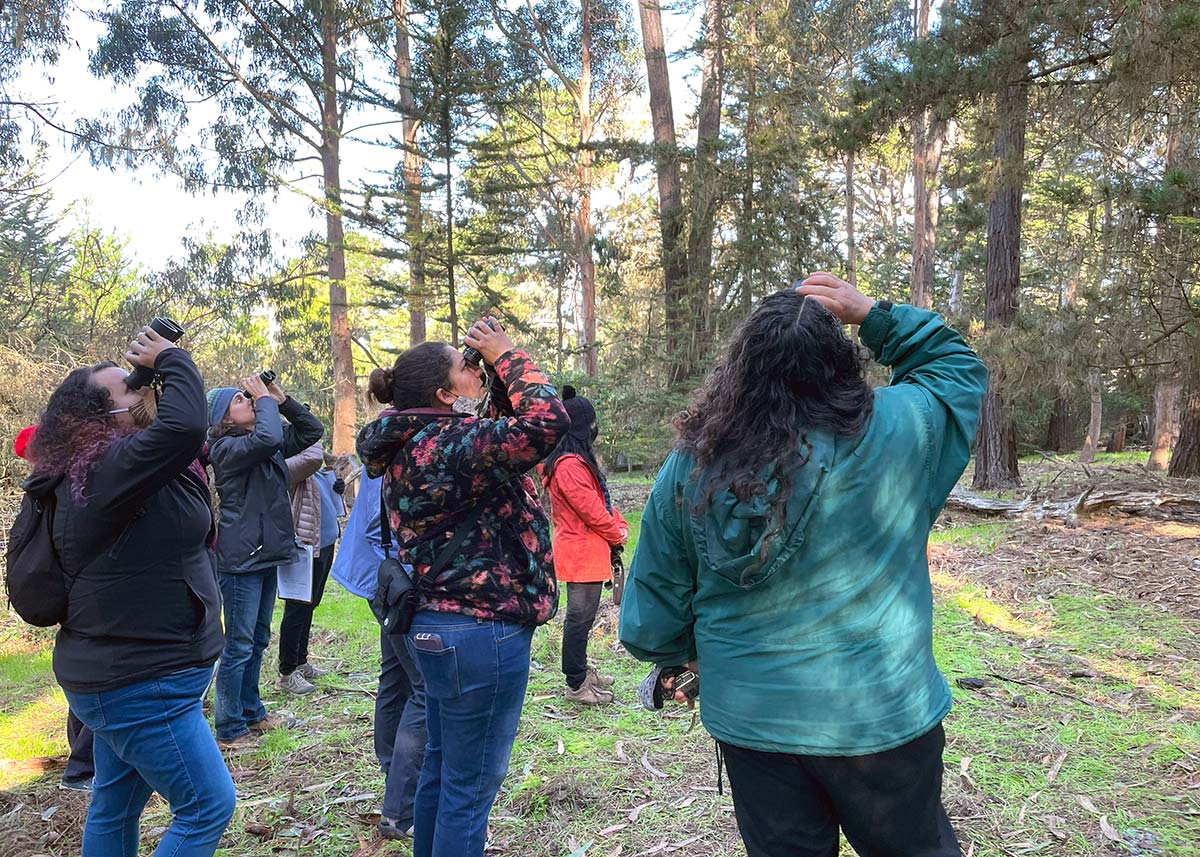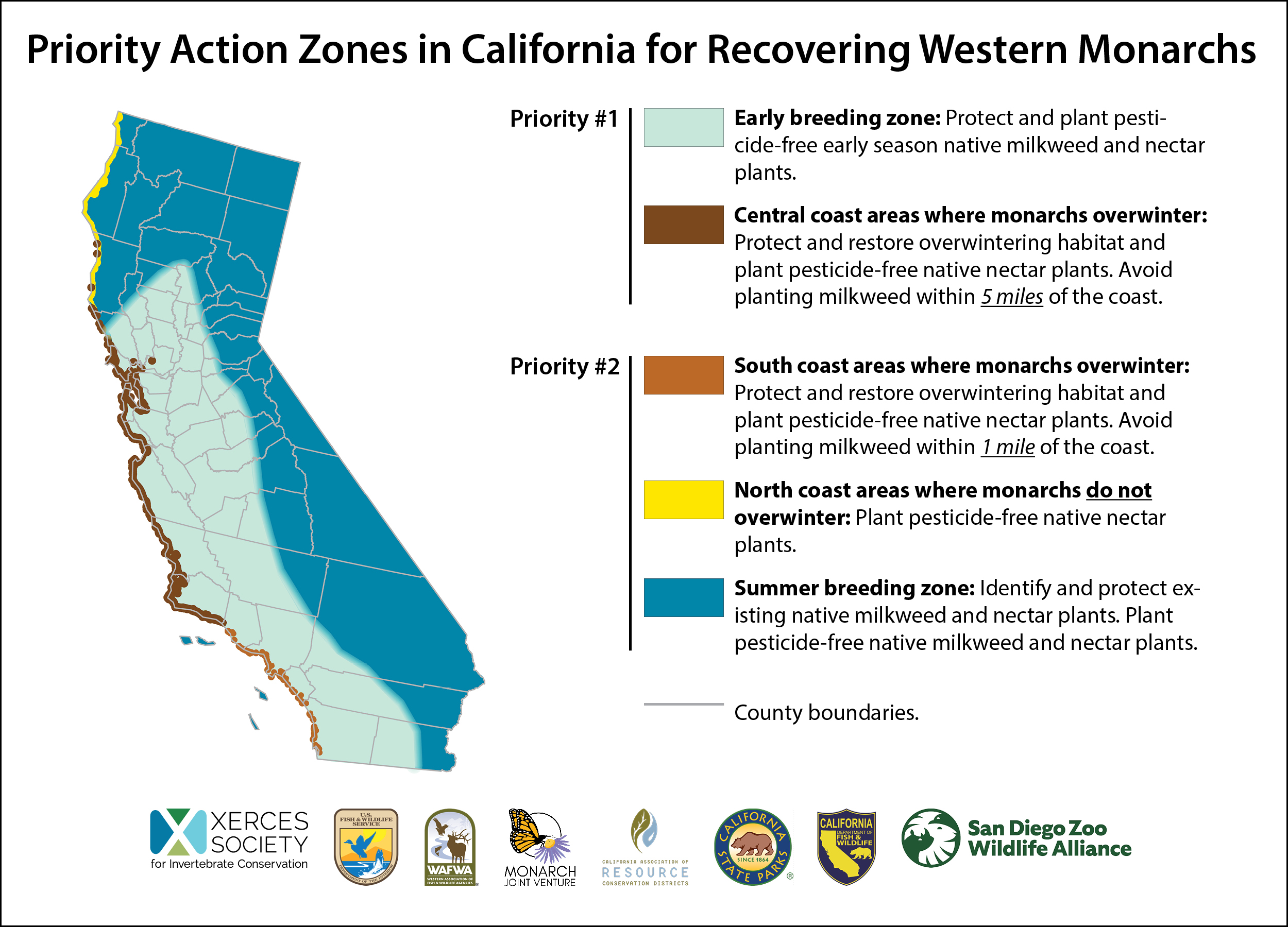Residents of California are uniquely positioned to help western monarchs because the state is home to overwintering sites, breeding grounds, and migration pathways. Monarchs can be found in California all year long, which means Californians have the opportunity to support their needs at all different stages of their lives and migration cycles. Here’s how!
1. Plant (the right) milkweed
Monarchs need milkweed plants to breed—their caterpillars eat milkweed leaves, and can only survive on a few other closely related host plant species. When western monarchs leave coastal overwintering sites, they need milkweed right away. Otherwise, they may not survive long enough or remain fertile enough to breed.
Californians are uniquely able to provide early-season milkweed species for breeding in early breeding zones. Early-season milkweed species native to California include woollypod (Asclepias eriocarpa), California (A. californica), and heartleaf (A. cordifolia). These emerge in March and April. Later-season native milkweed species in California include narrowleaf (A. fascicularis) and showy (A. speciosa).
These early-season milkweeds have historically been harder to find and have smaller native ranges. We’ve been working on a major project with the California Bureau of Land Management and Great Valley Seed Company to make seeds and transplants of these species available for habitat restoration. As the project comes to a close, we’ve successfully created a stable source for early-season milkweed in the San Joaquin Valley. We’re also sharing the process of how we grew the milkweed supply so that other vendors can follow suit.
Avoid planting non-native species like tropical milkweed (Asclepias curassavica). It’s easily found, but doesn’t die back in California’s temperate climate, so it allows for parasite buildup. Native species have evolved with native monarchs and can best support them.
Do not plant any milkweed species if you live too close to the coast. If you live north of Santa Barbara, don’t plant milkweed within five miles of the coast. If you live south of Santa Barbara, don’t plant milkweed within one mile of the coast. Milkweed doesn’t naturally grow close to the coast and can interrupt natural monarch overwintering behavior near their overwintering groves.
We provide guidance for establishing milkweed on the west coast. You can use our milkweed finder tool to find milkweed seed and plant vendors near you. Seek out early-season species if you live in early breeding zones. Plant a variety of native milkweed species to support monarch breeding throughout the spring and summer. The Western Monarch Milkweed Mapper species listing can help you determine which milkweed species will grow in your location.

2. Plant (the right) nectar plants
Monarchs drink nectar from flowers as an energy source. They need flowers (ideally native flowers) throughout their range in North America, but again Californians are perfectly posed to help during key times.
When monarchs are leaving overwintering sites in the spring, they’ve survived a long and hard winter and their populations are at their lowest numbers due to die-off from harsh conditions. Early breeding and migrating success is key to increasing population counts. Early breeding zones need both early-emerging milkweed and early-blooming nectar plants to support butterfly breeding and further migration.
During the autumn migration, monarchs also need nectar sources in California as they are headed toward overwintering sites. Some have flown for hundreds of miles and need energy from fall-blooming nectar plants to make it the rest of the way to the coast.
Coastal Californians can plant winter-blooming plants to provide monarchs at overwintering sites with valuable nectar from November through January.
We offer monarch nectar plant guides to help you determine which flower species are nectar-rich and native to your region. You can use our native plant, seed and services directory to find native nectar plant vendors near you.

3. Advocate for overwintering sites
Each year overwintering sites are destroyed or damaged by human activity like development or inappropriate tree trimming. Natural causes like severe weather, disease, and drought can also cause damage. Sometimes monarchs will abandon a damaged site. The majority of overwintering sites lack active management, putting them at risk of falling into disrepair.
If you live on the coast, you can become a steward for one or more overwintering sites. You can work with local landowners to protect and manage the tree groves in which monarchs spend the winter.
All Californians can contact their local and state elected officials and encourage them to protect overwintering groves.

4. Participate in community science research
We’re always seeking more information about monarchs to improve conservation plans. Californians can help generate data by joining community science projects that track overwintering behavior, spring migration patterns, early breeding success, and more on the west coast.
The Western Monarch Count invites Californians near the coast to count western monarchs at their overwintering sites from November to January. Volunteers count the overwintering butterflies around Thanksgiving and New Year’s, which helps us understand how many butterflies migrated to the coast in the fall, how many survived the worst of the winter, and how many are likely to migrate away from the coast in spring.
The Western Monarch Mystery Challenge is a community science project running from February to April, when monarchs start to migrate away from overwintering sites. The goal is to fill gaps in knowledge about western monarch migrations from coastal overwintering sites to summer breeding sites and California is a key part of that equation.
The Western Monarch Milkweed Mapper is an ongoing community science project to map milkweed and monarchs in all life stages in the western United States. Research from this project helps us understand how and where we can better support western monarchs in their breeding grounds.
Californians are also more than welcome to contribute to monarch community science projects that span a much wider geographic area, like the International Monarch Monitoring Blitz or the Monarch Nectar Plant Database.

5. Avoid pesticides
Pesticides are among the biggest threats to monarch butterflies. Caterpillars are particularly vulnerable to pesticides on milkweed plants, since they eat the leaves. A recent study has found that even though milkweed is often marketed as a plant to grow for butterflies, milkweeds at nurseries are often contaminated with harmful pesticides.
In our recent project with the California Bureau of Land Management and Great Valley Seed Company to expand access to early-season milkweed, the milkweed production field is in transition to certified organic. Limiting chemicals and weeding manually took additional time and resources, but monarchs being able to breed and feed in safer habitats is worth it. This is just one example of a pollinator-safe vendor. We have resources for you to learn how to talk to your plant vendors about their pest control practices. Talking to your vendor will help you access truly pollinator-safe plants and advocate for safer growing practices overall.
Once plants are growing in your space, don’t use pesticides. This includes herbicides, insecticides, fungicides, and other chemicals. If you do use pesticide as a last resort, at a minimum avoid long-lived systemic insecticides like neonicotinoids. We offer resources for alternative, ecological pest management that will help keep habitat safe for monarchs and other wildlife.

Monarchs need Californian’s help
We can’t protect western monarchs without participation from Californians. Much of our plan to increase western monarch populations relies on action in the state of California. Western monarch populations have declined dramatically since the 1980s. Please join us in supporting these vulnerable butterflies!





